Japanese design is synonymous with simplicity, elegance, and functionality. The minimalist charm of Japanese interiors has captured the hearts of many across the globe, and it’s easy to see why.
Do you know that the Japanese philosophy of “wabi-sabi” — finding beauty in imperfection — has influenced some of the most iconic interior designs, including the living room?
If you’re looking to create a serene and balanced atmosphere in your living room, Japanese style might be exactly what you need. This design style combines clean lines, natural materials, and an emphasis on tranquility, making it perfect for modern homes.
In this post, we’ll explore 10 stunning Japanese-style living room inspirations that can transform your space into a peaceful haven. Whether you’re aiming for a traditional look or a modern twist, you’ll find some fantastic ideas to suit your taste.
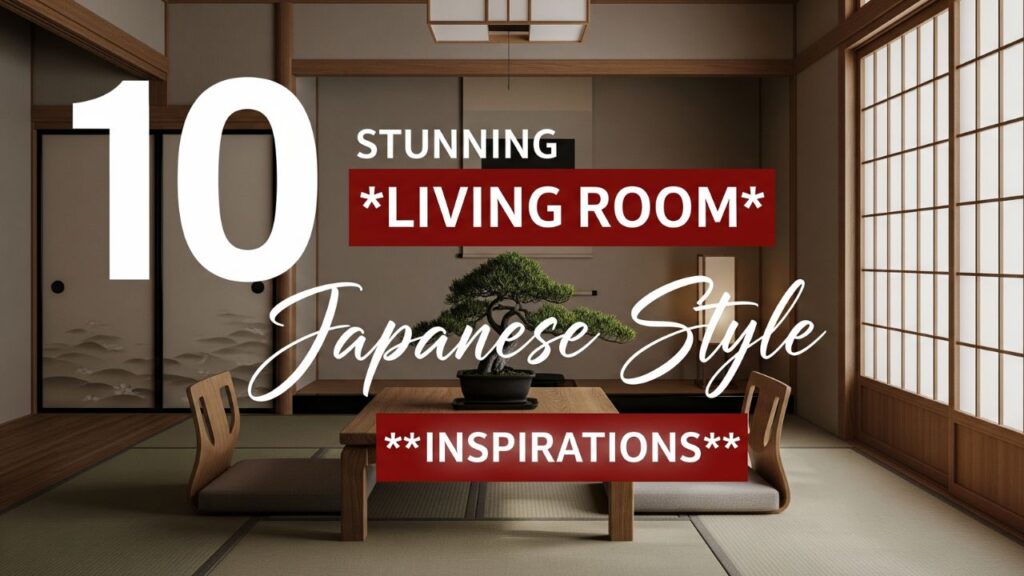
Table of Contents
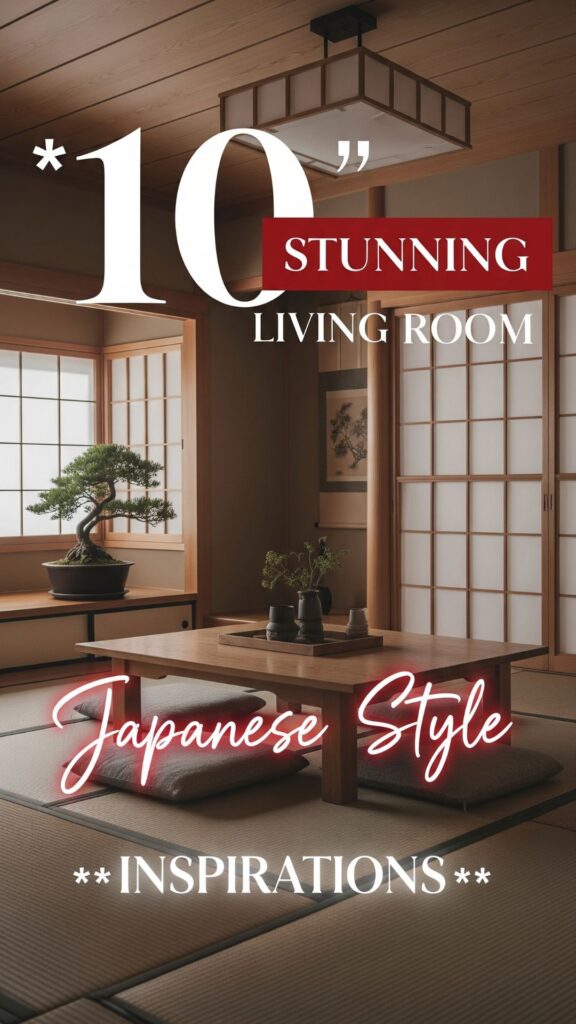
10 Stunning Living Room Japanese Style
1. The Traditional Japanese Room: Tatami Mats and Shoji Screens
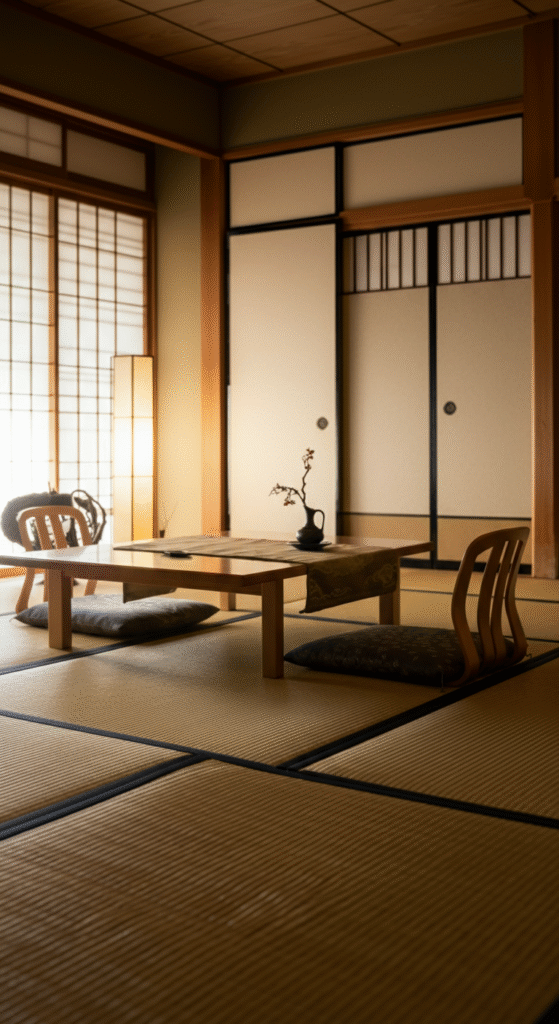
When we think of traditional Japanese living rooms, the first thing that comes to mind is tatami mats and shoji screens. The tatami mat, woven from rice straw, provides a soft yet firm foundation for sitting, while shoji screens, with their translucent paper, allow natural light to filter gently into the room.
Did you know?
Shoji screens have been a staple of Japanese architecture for centuries. Not only do they create privacy and separate spaces, but they also contribute to the overall aesthetic by diffusing light, which creates a peaceful ambiance in the room.
To recreate this look, you can invest in tatami mats for the flooring, combined with low-profile furniture, such as a low wooden coffee table or a futon-style seating arrangement. Shoji screens can be placed on windows or used to separate the living area from the dining area.
2. Incorporating Minimalist Furniture
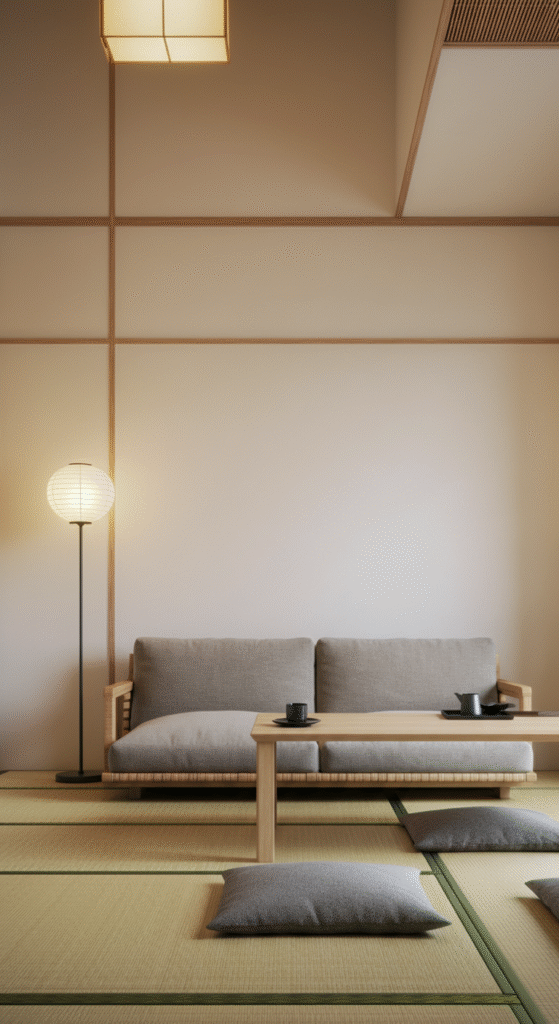
Minimalism is at the heart of Japanese interior design. Japanese living rooms often feature sleek, functional furniture that serves a purpose without taking up much space. Low-profile seating like floor cushions or low wooden chairs are perfect for achieving that calm, relaxed feel.
Interesting Fact:
The Japanese aesthetic embraces the idea of “less is more.” This not only applies to the number of items in a room but also to the design of the furniture itself. Simple, clean lines and muted colors dominate the Japanese interior, which helps create an environment that promotes calmness and mindfulness.
For a minimalist Japanese living room, choose pieces with neutral tones, like beige, white, or gray. Opt for a low-profile couch or a futon-style bed to enhance the aesthetic.
3. Natural Wood Elements for Warmth and Texture
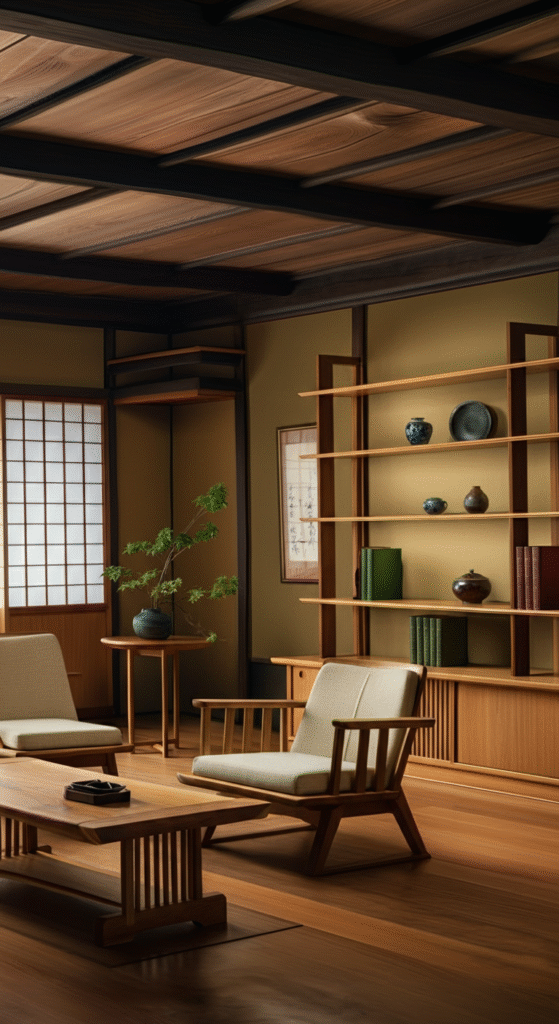
Wood plays a significant role in Japanese interiors, adding warmth and texture to the space. Wood is used in everything from flooring to furniture to accent walls, and it’s essential to creating an authentic Japanese living room.
Did you know?
Japanese carpenters often use a technique known as “Kintsugi,” where broken pottery is repaired with gold, highlighting the imperfection as part of its beauty. Similarly, the use of wood in Japanese interiors embraces natural imperfections, creating a connection to nature.
To infuse natural wood into your living room, consider wooden furniture like coffee tables, bookshelves, or sideboards. You can also incorporate wood elements in the form of a wooden accent wall or a wooden beam ceiling to add texture and richness.
4. Zen-inspired Features for Serenity
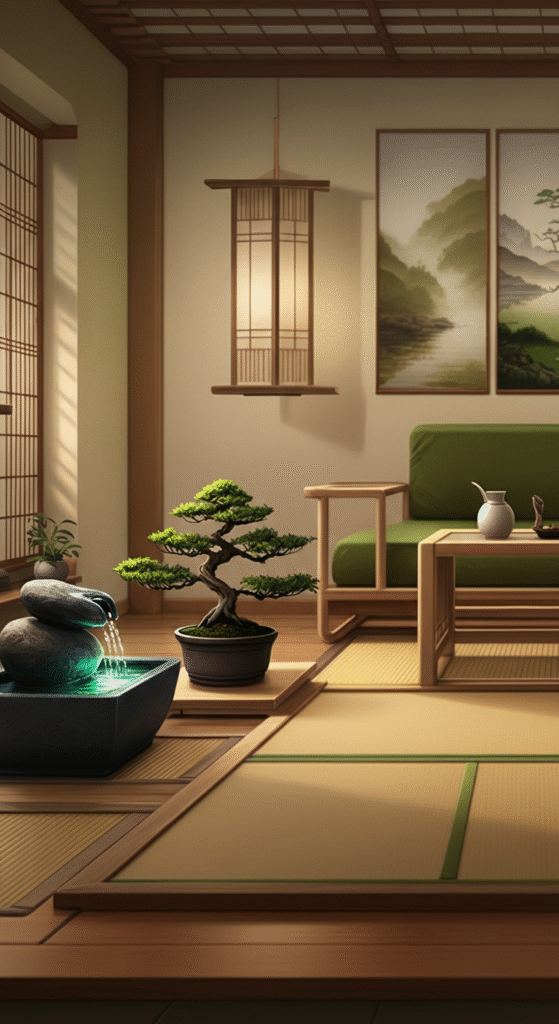
A key element in Japanese design is creating a space of tranquility and reflection. Incorporating Zen-inspired features like indoor plants, small water fountains, or simple artwork can bring a sense of calm and balance to your living room.
Myth Busting:
Many people believe that Zen spaces are only about bare walls and empty floors, but that’s not entirely true. Zen-inspired spaces focus on balance and harmony, not on empty minimalism. It’s about creating a serene environment where everything has its place, and nothing is superfluous.
To incorporate a Zen-inspired atmosphere, add some indoor plants like bonsai trees or peace lilies. A small indoor fountain can also provide the calming sound of running water, which is central to creating a peaceful living room.
5. Japanese Color Palette: Calm and Neutral Tones
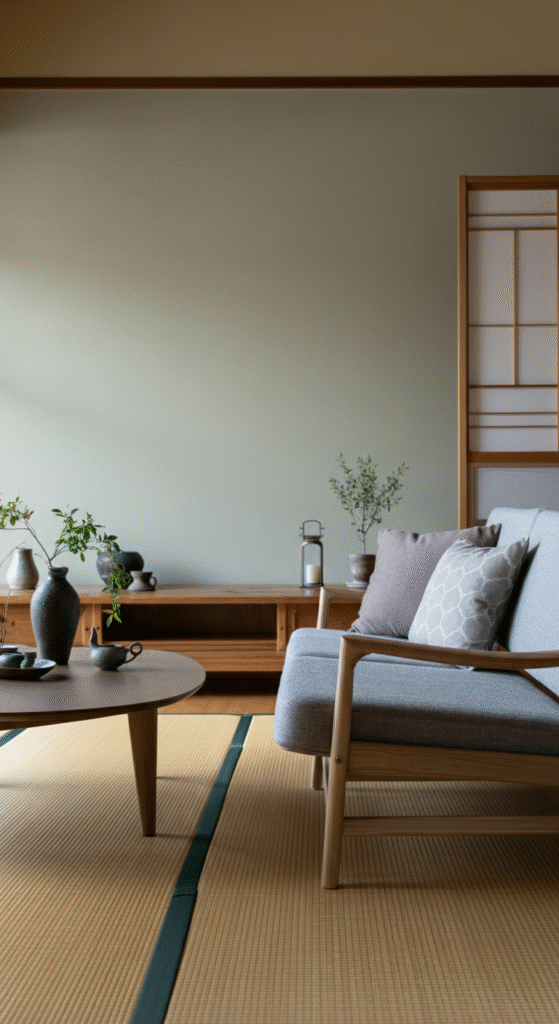
The color palette in a Japanese-style living room is all about calm, neutral shades that reflect the tranquility of nature. Soft whites, grays, earth tones, and muted greens are commonly used to create a harmonious and serene atmosphere.
Did you know?
Japanese color symbolism goes beyond just aesthetics. Colors like white symbolize purity and simplicity, while earthy tones represent groundedness and natural beauty. By using these colors, you can create a soothing environment that promotes relaxation.
To create the perfect Japanese-inspired color scheme, opt for soft white or beige walls, paired with muted tones in furniture and decor. You can add accents of green with indoor plants to bring life into the room.
6. Japanese Lighting: Soft and Subtle
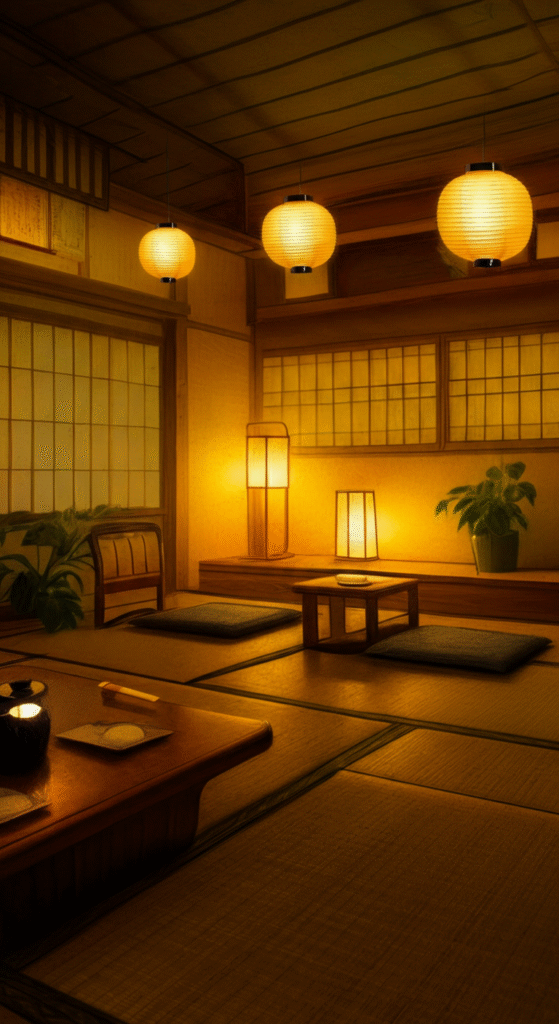
In Japanese interiors, lighting is not just a functional element but an integral part of the design. The light is meant to create a soft, diffused glow rather than harsh, direct light. This effect is often achieved using paper lanterns, shoji screens, and other soft light sources.
Interesting Fact:
The Japanese concept of “kōjō” refers to the soft, golden light that filters through paper screens, creating a serene and inviting environment. This type of lighting is said to enhance the mood of the space, making it feel warm and comforting.
To achieve this look in your living room, incorporate soft lighting sources like paper lanterns or dimmable ceiling lights. Avoid overly bright or direct lighting that can disrupt the calming effect.
7. Open Spaces and Airy Layouts
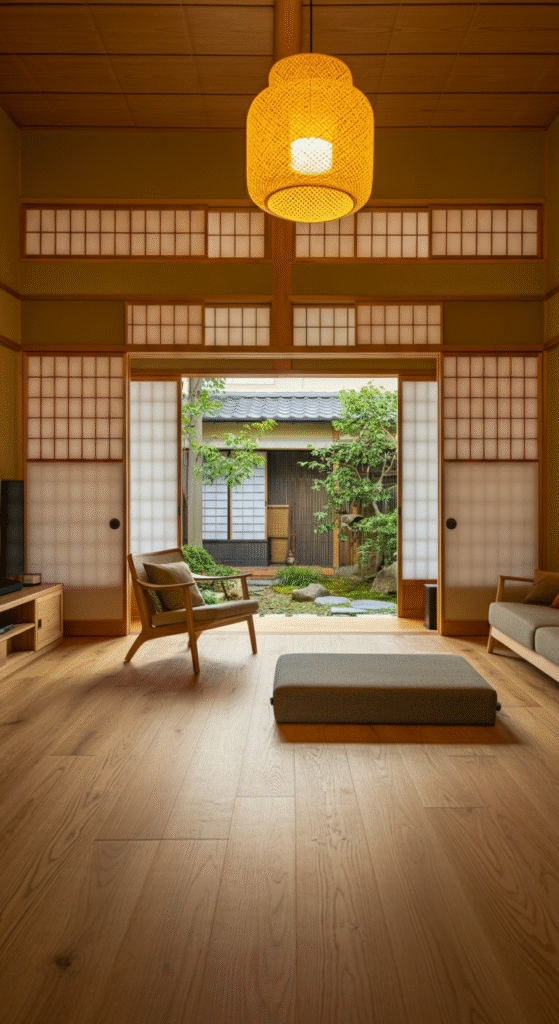
Japanese living rooms often emphasize open spaces with an airy layout that promotes freedom and flow. In a traditional Japanese room, walls are often kept minimal to maintain an open, fluid feel between spaces.
Did you know?
Japanese homes traditionally have sliding doors instead of fixed walls, which can be opened or closed to create larger or smaller spaces as needed. This allows the living room to feel more expansive and adaptable to the needs of the household.
To achieve a sense of openness in your living room, keep furniture minimal and avoid overcrowding the space with too many pieces. Use sliding doors or open shelving to create a sense of flow while maintaining the Japanese aesthetic.
8. Incorporating Japanese Artwork
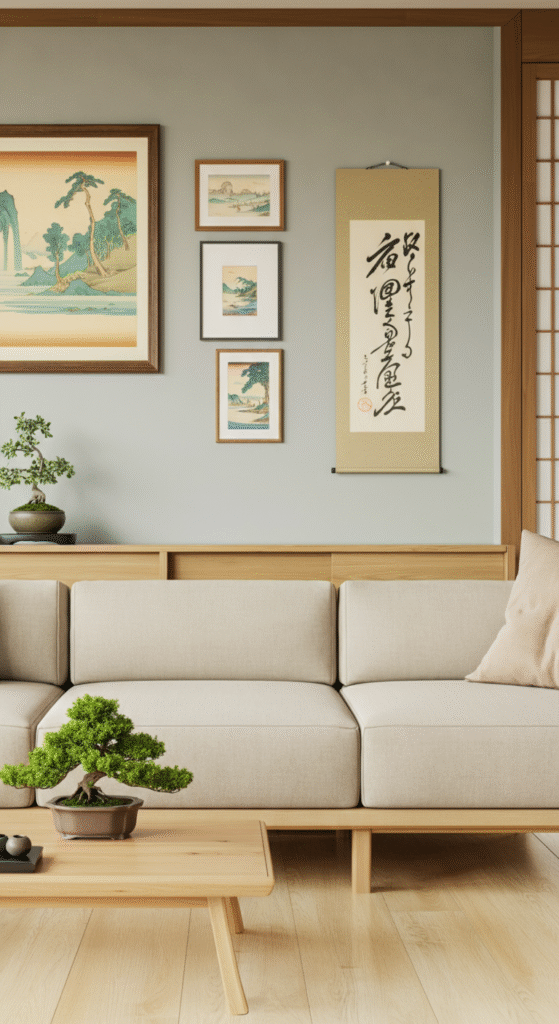
Artwork is an important element in Japanese interiors, often reflecting nature, traditional motifs, and the changing seasons. You can incorporate Japanese-style artwork into your living room through paintings, calligraphy, or wall hangings.
Interesting Fact:
Japanese artwork often features elements of nature, such as cherry blossoms, birds, and mountains, symbolizing the fleeting beauty of life. These motifs are deeply rooted in the culture’s appreciation for impermanence.
Add Japanese artwork to your living room by framing traditional Japanese prints or calligraphy. You can also use a large statement piece like a cherry blossom painting to add color and visual interest to the room.
9. The Beauty of Japanese Sliding Doors (Fusuma)
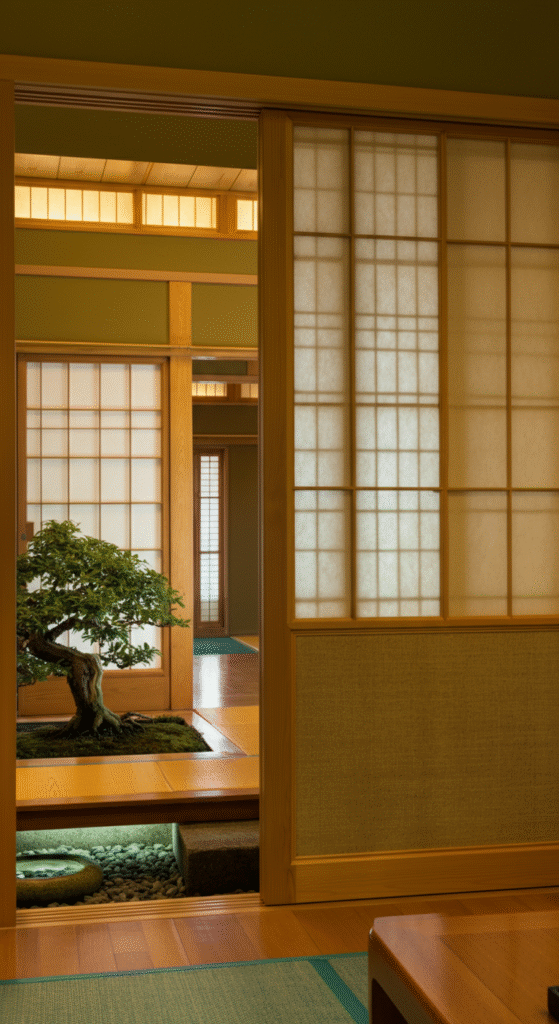
Fusuma, or sliding doors, are a common feature in traditional Japanese homes. These doors are used to separate different areas within the home, and their sliding nature allows for flexibility in the layout of a room.
Myth Busting:
Some believe that sliding doors only belong in traditional homes, but modern interpretations of Fusuma can add a touch of sophistication and practicality to any home. Their flexibility makes them ideal for both traditional and contemporary settings.
Consider adding Fusuma doors to your living room to enhance the Japanese style. These doors can be used to separate the living room from other areas or even as a decorative element when placed against a wall.
10. Outdoor Connection: Japanese-inspired Courtyards
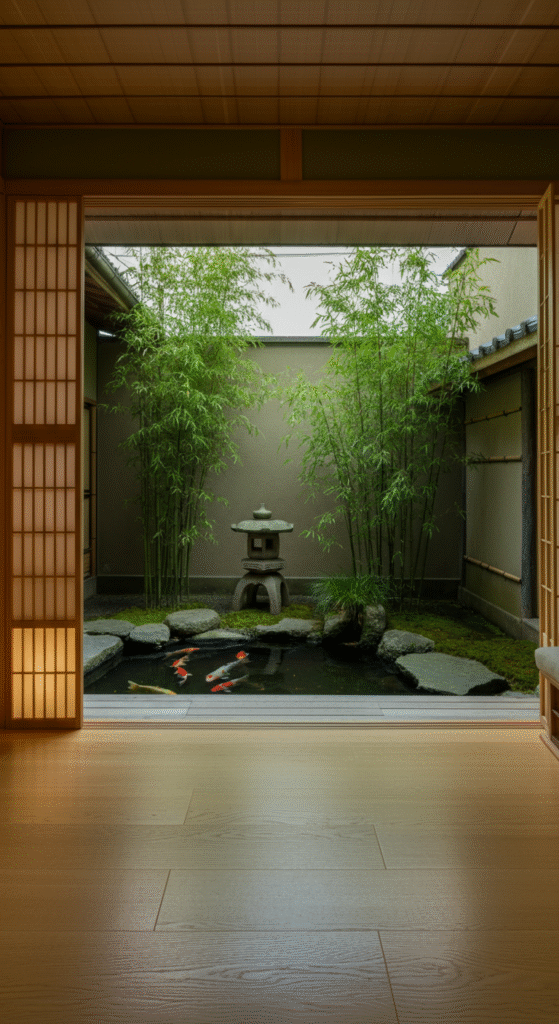
Many traditional Japanese homes incorporate courtyards or gardens, creating an outdoor space that can be seen from the living room. This connection to nature is a fundamental aspect of Japanese design, where the boundary between the indoor and outdoor is blurred.
Did you know?
Japanese gardens are designed to reflect harmony with nature. Elements like water, stones, and plants are carefully arranged to create a space that feels peaceful and balanced.
If you have the space, consider adding an outdoor garden or courtyard visible from your living room. You can include Japanese-style landscaping with bamboo, stones, and a small koi pond to bring the outdoors inside.
Conclusion
Creating a Japanese-style living room is all about embracing simplicity, balance, and natural elements.
Whether you prefer the serene beauty of traditional Japanese interiors or a more modern take on the style, these 10 stunning inspirations will help you transform your living room into a peaceful and inviting space.
Remember, Japanese interiors are more than just a design choice; they are a reflection of a philosophy that values minimalism, natural beauty, and tranquility.
By incorporating these elements into your living room, you can create a space that feels like a serene retreat from the hustle and bustle of daily life.
Frequently Asked Questions (FAQs)
What are the key features of a Japanese-style living room?
Japanese-style living rooms typically feature minimalist furniture, natural materials like wood and bamboo, soft lighting, and neutral color palettes. Key elements include tatami mats, low-profile furniture, shoji screens, and Zen-inspired decorations. The goal is to create a serene, clutter-free space that connects with nature.
How can I incorporate Japanese design into a small living room?
To incorporate Japanese design into a small living room, focus on simplicity and functionality. Opt for low-profile, minimalist furniture that doesn’t overwhelm the space. Use light-colored walls, shoji screens, and natural materials like wood or bamboo to give the room an airy, open feel. Keep clutter to a minimum and choose compact furniture pieces that are practical without sacrificing style.
Can I blend modern and traditional Japanese styles?
Yes, blending modern and traditional Japanese styles is not only possible but can result in a unique and harmonious design. You can incorporate traditional elements such as tatami mats or shoji screens alongside modern minimalist furniture. Use contemporary art, lighting, and sleek furniture to create a fusion of old and new, making the space feel both timeless and fresh.
What is the significance of the color palette in Japanese living rooms?
The color palette in Japanese interiors typically consists of neutral tones like whites, beiges, grays, and earth tones. These colors promote tranquility and a connection to nature. Soft greens are often included through plants, creating a calming, zen-like atmosphere. The colors help maintain the serene and minimalist ambiance that is central to Japanese design.
Are Japanese sliding doors practical for modern homes?
Yes, Japanese sliding doors (Fusuma) are highly practical for modern homes. They allow for flexibility in room layout, as they can be opened to create larger spaces or closed to create privacy. In addition, they are a great option for saving space in smaller rooms, making them ideal for apartments or homes where space is limited. Modern versions of Fusuma doors can be customized with stylish designs to suit contemporary tastes.










